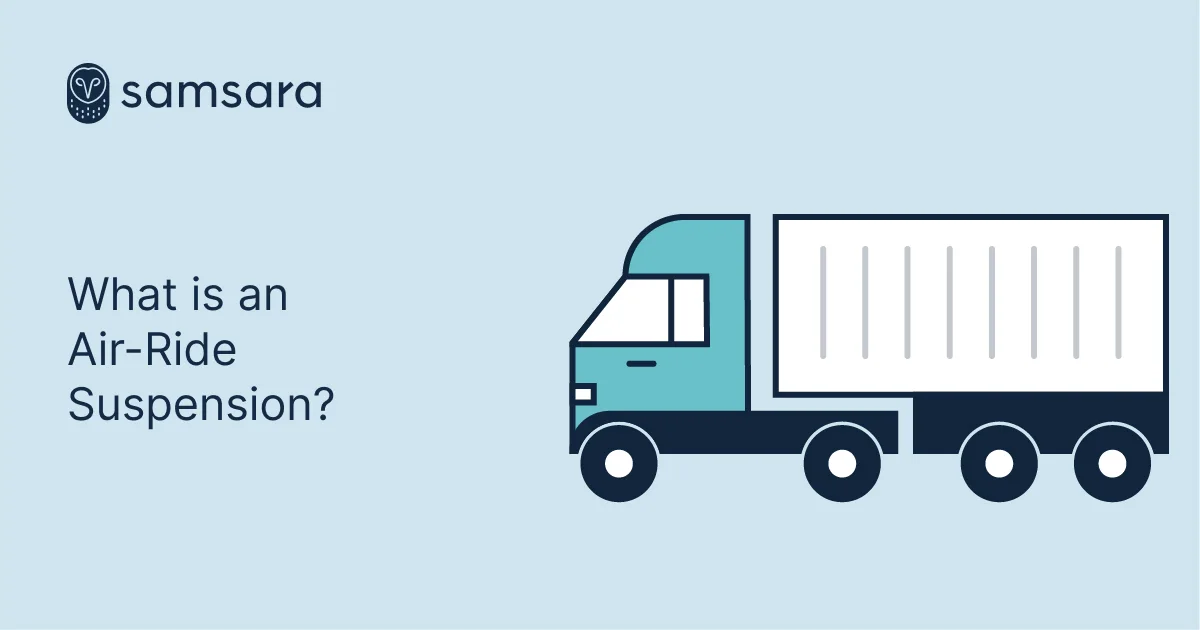What is an Air-Ride Suspension?
October 22, 2021

Get Started With Samsara
Check Our PricesKey Takeaways
An air-ride suspension is a standard feature on most over-the-road vehicles. They offer a smoother ride over spring suspensions, making them a popular choice with drivers. Learn more about the benefits and drawbacks of an air-ride suspension.
What is an air-ride suspension?
An air-ride suspension is a kind of suspension that supports the load on air-filled rubber bags rather than steel springs. Compressed air is supplied by the same engine-driven air compressor and reservoir tanks that provide air to the air brake system.
Typically, air-ride suspension systems are the standard of over-the-road vehicles. Meanwhile, vocational vehicles—such as garbage trucks or dump trucks—use leaf spring suspensions because of their greater durability and capacity.
What is the difference between an air-ride and leaf spring suspension?
The biggest difference between the two types of suspensions is how they absorb road impact.
Leaf spring suspensions use layers of strips known as a leaf pack. These strips or leaves are attached to the trailer frame. The vehicle’s axle is then attached to the center of the leaves. The leaves compress and absorb the motion when the axle moves instead of transferring energy to the chassis.
Air ride suspensions cushion the shock using valves, air lines, air tanks, and air spring bags or bellows. Air suspensions use the same air compressor as the truck’s braking system. The compressor supplies air to the bags, which act as springs.
Many drivers prefer the air suspension as it improves ride quality over long distances. Drivers report they experienced more fatigue when using a leaf spring suspension due to the jarring movement of the cab while driving.
The benefits and drawbacks of an air suspension system
Depending on the needs of the business, fleet managers can decide whether to get vehicles with air-ride suspensions. Here are some of the benefits and drawbacks to be aware of.
Benefits
Comfortable ride: Air bags allow for a much smoother ride over metal coil springs.
Ride control: By using the control system to adjust the air pressure, drivers can ensure both light and heavy loads are level and stable.
Varied ride height: An air suspension improves the ride height based on the load weight and vehicle’s speed.
Extended life of assets: With less vibrations, there’s less wear and tear on suspension systems and trailers, reducing overall costs.
Drawbacks
Expense: Both original equipment manufacturer (OEM) and aftermarket air suspensions can cost more to install and repair than leaf spring suspensions.
Installation: While today’s air ride suspension kits have reduced the need for cutting and drilling as much, suspension products still require professional installation.
Reliability: Unless they’re high-quality, air bags can spring leaks and even burst, resulting in malfunctions, even compromising brake systems.
Maintenance vulnerabilities: These systems can be prone to common repairs including, rust or moisture damage, compressor burn-out, and tubing leaks or failures. Setting up preventive maintenance helps extend their life.
Fuel consumption: Air suspensions are heavier weight than leaf suspensions, potentially causing more fuel consumption. It also costs more fuel to run the compressor.